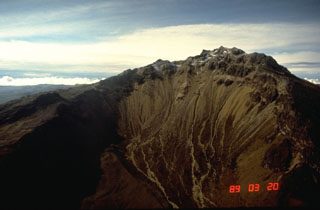Report on Cumbal (Colombia) — September 1990
Bulletin of the Global Volcanism Network, vol. 15, no. 9 (September 1990)
Managing Editor: Lindsay McClelland.
Cumbal (Colombia) Fumaroles outside of main crater
Please cite this report as:
Global Volcanism Program, 1990. Report on Cumbal (Colombia) (McClelland, L., ed.). Bulletin of the Global Volcanism Network, 15:9. Smithsonian Institution. https://doi.org/10.5479/si.GVP.BGVN199009-351100
Cumbal
Colombia
0.95°N, 77.87°W; summit elev. 4764 m
All times are local (unless otherwise noted)
The central ash cone of Cumbal, ~300 m high, was seen by two observers from the caldera rim on 31 July. A large area of fumaroles ~50 m below the summit was emitting a large plume of white gas, and a smaller vent was active ~15 m below the summit. The interior of the central crater was not observed.
Geological Summary. Many youthful lava flows extend from the glacier-capped Cumbal volcano, the southernmost historically active volcano of Colombia. The volcano is elongated in a NE-SW direction and is composed primarily of andesitic-dacitic lava flows. Two fumarolically active craters occupy the summit ridge: the main crater on the NE side and Mundo Nuevo crater on the SW. A young lava dome occupies the 250-m-wide summit crater, and eruptions from the upper E flank produced a 6-km-long lava field. The oldest crater lies NNE of the summit crater, suggesting SW-ward migration of activity. Explosive eruptions in 1877 and 1926 are the only known historical activity. Thermal springs are located on the SE flanks.
Information Contacts: S. Hodges, Univ of Oxford. The Oxford field team also included J. Bass, S. Crampton, J. Dinares, S. Hart, R. Hartley, C. Mandeville, M. More, K. Ogden, J. Scarrow, and A. Whittingham.

